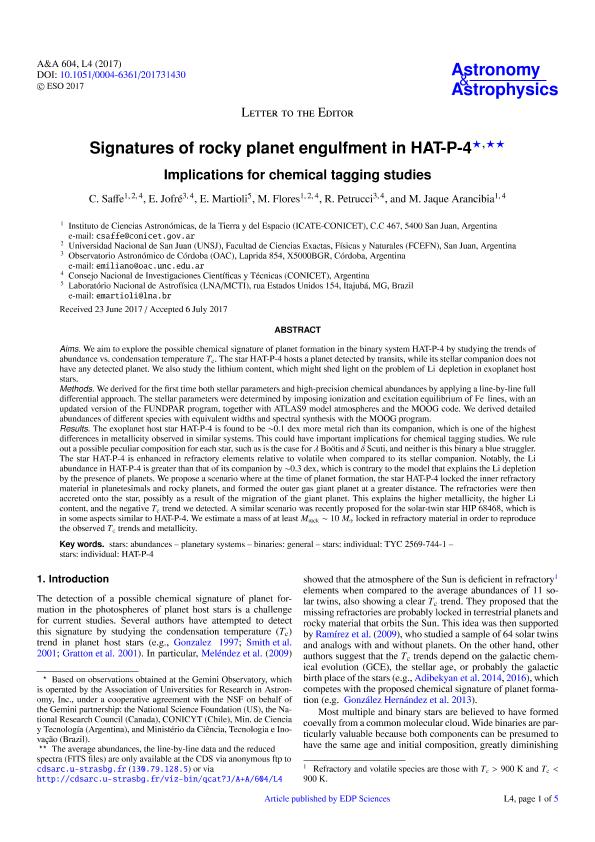Mostrar el registro sencillo del ítem
dc.contributor.author
Saffe, Carlos

dc.contributor.author
Jofre, Jorge Emiliano

dc.contributor.author
Martioli, E.
dc.contributor.author
Flores, Matias
dc.contributor.author
Petrucci, Romina Paola

dc.contributor.author
Jaque Arancibia, Marcelo Daniel

dc.date.available
2018-10-29T15:11:31Z
dc.date.issued
2017-08
dc.identifier.citation
Saffe, Carlos; Jofre, Jorge Emiliano; Martioli, E.; Flores, Matias; Petrucci, Romina Paola; et al.; Signatures of rocky planet engulfment in HAT-P-4: Implications for chemical tagging studies; EDP Sciences; Astronomy and Astrophysics; 604; 8-2017; 1-5; L4
dc.identifier.issn
0004-6361
dc.identifier.uri
http://hdl.handle.net/11336/63180
dc.description.abstract
Aims. We aim to explore the possible chemical signature of planet formation in the binary system HAT-P-4 by studying the trends of abundance vs. condensation temperature Tc. The star HAT-P-4 hosts a planet detected by transits, while its stellar companion does not have any detected planet. We also study the lithium content, which might shed light on the problem of Li depletion in exoplanet host stars. Methods. We derived for the first time both stellar parameters and high-precision chemical abundances by applying a line-by-line full differential approach. The stellar parameters were determined by imposing ionization and excitation equilibrium of Fe lines, with an updated version of the FUNDPAR program, together with ATLAS9 model atmospheres and the MOOG code. We derived detailed abundances of different species with equivalent widths and spectral synthesis with the MOOG program. Results. The exoplanet host star HAT-P-4 is found to be ∼0.1 dex more metal rich than its companion, which is one of the highest differences in metallicity observed in similar systems. This could have important implications for chemical tagging studies. We rule out a possible peculiar composition for each star, such as is the case for λ Boötis and δ Scuti, and neither is this binary a blue straggler. The star HAT-P-4 is enhanced in refractory elements relative to volatile when compared to its stellar companion. Notably, the Li abundance in HAT-P-4 is greater than that of its companion by ∼0.3 dex, which is contrary to the model that explains the Li depletion by the presence of planets. We propose a scenario where at the time of planet formation, the star HAT-P-4 locked the inner refractory material in planetesimals and rocky planets, and formed the outer gas giant planet at a greater distance. The refractories were then accreted onto the star, possibly as a result of the migration of the giant planet. This explains the higher metallicity, the higher Li content, and the negative Tc trend we detected. A similar scenario was recently proposed for the solar-twin star HIP 68468, which is in some aspects similar to HAT-P-4. We estimate a mass of at least Mrock ∼ 10 M⊕ locked in refractory material in order to reproduce the observed Tc trends and metallicity.
dc.format
application/pdf
dc.language.iso
eng
dc.publisher
EDP Sciences

dc.rights
info:eu-repo/semantics/openAccess
dc.rights.uri
https://creativecommons.org/licenses/by-nc-sa/2.5/ar/
dc.subject
Binaries: General
dc.subject
Planetary Systems
dc.subject
Stars: Abundances
dc.subject
Stars: Individual: Hat-P-4
dc.subject
Stars: Individual: Tyc 2569-744-1
dc.subject.classification
Astronomía

dc.subject.classification
Ciencias Físicas

dc.subject.classification
CIENCIAS NATURALES Y EXACTAS

dc.title
Signatures of rocky planet engulfment in HAT-P-4: Implications for chemical tagging studies
dc.type
info:eu-repo/semantics/article
dc.type
info:ar-repo/semantics/artículo
dc.type
info:eu-repo/semantics/publishedVersion
dc.date.updated
2018-10-22T17:27:30Z
dc.journal.volume
604
dc.journal.pagination
1-5; L4
dc.journal.pais
Francia

dc.description.fil
Fil: Saffe, Carlos. Consejo Nacional de Investigaciones Científicas y Técnicas. Centro Científico Tecnológico Conicet - San Juan. Instituto de Ciencias Astronómicas, de la Tierra y del Espacio. Universidad Nacional de San Juan. Instituto de Ciencias Astronómicas, de la Tierra y del Espacio; Argentina
dc.description.fil
Fil: Jofre, Jorge Emiliano. Universidad Nacional de Cordoba. Observatorio Astronomico de Cordoba; Argentina. Consejo Nacional de Investigaciones Científicas y Técnicas; Argentina
dc.description.fil
Fil: Martioli, E.. Laboratório Nacional de Astrofísica; Brasil
dc.description.fil
Fil: Flores, Matias. Consejo Nacional de Investigaciones Científicas y Técnicas. Centro Científico Tecnológico Conicet - San Juan. Instituto de Ciencias Astronómicas, de la Tierra y del Espacio. Universidad Nacional de San Juan. Instituto de Ciencias Astronómicas, de la Tierra y del Espacio; Argentina
dc.description.fil
Fil: Petrucci, Romina Paola. Universidad Nacional de Cordoba. Observatorio Astronomico de Cordoba; Argentina. Consejo Nacional de Investigaciones Científicas y Técnicas; Argentina
dc.description.fil
Fil: Jaque Arancibia, Marcelo Daniel. Consejo Nacional de Investigaciones Científicas y Técnicas. Centro Científico Tecnológico Conicet - San Juan. Instituto de Ciencias Astronómicas, de la Tierra y del Espacio. Universidad Nacional de San Juan. Instituto de Ciencias Astronómicas, de la Tierra y del Espacio; Argentina
dc.journal.title
Astronomy and Astrophysics

dc.relation.alternativeid
info:eu-repo/semantics/altIdentifier/url/https://www.aanda.org/articles/aa/pdf/2017/08/aa31430-17.pdf
dc.relation.alternativeid
info:eu-repo/semantics/altIdentifier/doi/http://dx.doi.org/10.1051/0004-6361/201731430
Archivos asociados
